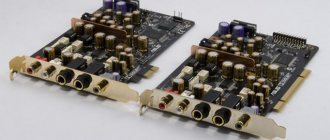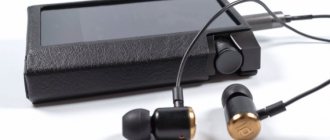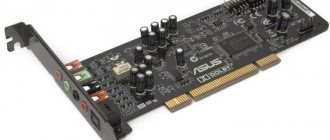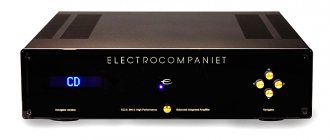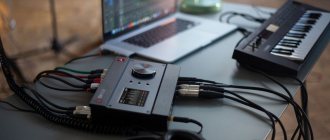Asus Essence III
External audiophile USB DAC/headphone amplifier, with support for ASIO and DSD Asus Essence III - Hi-End USB DAC/headphone amplifier, with direct DSD support throughout the entire path. This is a component of the highest price category, surpassing in capabilities all previous Asus audio interfaces. Among the mind-blowing features, there are balanced microXLR outputs (separate connectors for the right and left channels) for connecting Hi-End headphone models. Let’s say right away that the cost of such a device is also quite high: about 90 thousand rubles.
From old-timers in the audio industry we hear perplexed questions: “What has Asus forgotten in the Hi-End equipment market? Let him deal with his video cards and motherboards and not interfere in his own sphere, where everything is already divided.” However, similar statements were made every time Asus entered new markets, for example, the laptop or router market. However, now Asus is number one in Russia for laptops, and every fifth router sold in Russia bears the Asus logo.
Let's get back to the sound. Let us remind you that Asus has been producing high-quality sound cards for computers since 2007 and is already known for its achievements in this area. Thus, in 2009, a very successful model, Xonar Essence ST/STX, was released, exclusively featuring a senior TI PCM1792A DAC and a powerful TPA6120A2 headphone amplifier. The name of the entire series of Essence cards can be translated into Russian as “quintessence”. Although the Essence ST/STX was not perfect (there are questions about the 44 kHz mode), the user received very good sound for not very much money. Our tests confirmed the high class of the product. Competitors were practically unable to oppose him.
There is no doubt that Asus liked the empty niche of high-end audio devices for PCs, and to strengthen its position, the company began developing Essence One. For this purpose, a separate large team of engineers was formed with good funding for research (R&D). In the Essence One external DAC, the company managed to really turn around. The device turned out to be quite expensive for a computer sound card, but at the same time very attractive in terms of the combination of price and quality by the standards of household DACs and headphone amplifiers. Inspired by success, Asus decided to take the next height - expensive Hi-Fi/Hi-End equipment. At the same time, the company has strengthened its line of more mainstream devices with new models Asus U7 and Asus STU, covering all price ranges with products.
What's new in the Hi-End sector? The latest fashion among audiophiles is to have DSD files and SACD images in your media library that fully correspond to the studio original. Now this can be done completely legally by purchasing a recording on the Internet, and not entirely legally by downloading an ISO image of a SACD disc obtained from a Sony PS3 drive firmware hack on the Internet. This distribution path is exactly the same as the distribution of MP3 over the Internet. One of the positive aspects of this phenomenon is the increased interest in the topic among audiophiles and a powerful impetus for the release of equipment with DSD support.
In principle, it is possible to listen to SACD on any sound card. But this is only possible with DSD→PCM conversion on the fly, in a software player. With the advent of direct DSD support in the latest version of the ASIO SDK, many modern professional devices now have the opportunity to pass such a signal to the DAC, bypassing all the nooks and crannies of Windows. That is, the signal passes along a special direct path, without any conversion throughout the entire chain “disk image file → card driver → converter chip.”
The most interesting thing is that the Asus Essence III has a completely direct playback path of DSD data. Moreover, the rather rare Analog Devices DAC chip used in this device has a separate DSD input and separate modulator and filter circuits, without conversion to PCM. In many universal DSD/PCM chips, various tricks and simplified circuits are often used for reasons of economy.
With the Asus Essence III, we conducted a small experiment: we launched two free foobar2000 players in a portable setup with DSD→PCM conversion enabled in one of them, and in the other feeding the DSD signal directly to the DAC. Simultaneous playback of these two different formats is impossible, but through the “stop” button and a short delay of 2 seconds, such an experiment can be carried out.
The first thing that caused our surprise was the significantly different volumes of the DSD and PCM versions of the same soundtrack. Second: the DSD→PCM conversion plugin offers too many different options, and the best option is completely unclear. Third: the sound as a whole is no different. But although PCM sounds smoother in detail, the aggression and some of the details of the DSD stereo panorama disappear from the sound. It is not clear how well and error-free format conversion is implemented, as well as into which PCM space it is output. By indirect evidence, this is 16 bit 44 kHz. It is unclear: why this particular format was chosen and why it cannot be changed? Why does one media player have some conversion options, while another does not have them at all? This clarifies the main point of directly feeding the DSD stream to the DAC: to avoid any interference with the signal . In any case, it's nicer to have a choice. Direct DSD listening certainly has its charm. And the differences here are obvious. (The whole idea as a whole is much healthier than traditional audiophile fun with choosing the orientation of a 220 V network cable.)
The accuracy of DSD→PCM conversion in the plugin as a whole is beyond doubt - the music is played back correctly. Rather, it is the additional processing that is of concern. We didn't like the lower default volume. I also didn’t like the ability to set any arbitrary volume - mathematically this is multiplication with rounding. Choosing the optimal plugin settings also causes difficulties. (If some of the recalculation modes are of lower quality, why are they needed there at all? Maybe this is a demonstration of the powerful skills of the programmers of a free plugin? They will certainly need it as a portfolio, but the listener is more interested in the applicability of all the options in real life.)
In addition to direct DSD support, which immediately increases the value of the device, the Asus Essence III has many other interesting things to offer. In the world of audiophile equipment, Essence III would be called a combine, since it contains simultaneously a USB DAC, a preamplifier-switcher, and a headphone amplifier. Each of these components has its own original implementation and unusual circuit design with a high objective quality of implementation. Some features serve to satisfy the needs of a wealthy audiophile audience. Others are not without engineering sense. Let's take a closer look.
The power supply contains independent power circuits for the left and right channels. This works well for channel separation. TI TPS 7A4700 and 7A3301 LDO regulators, as their name suggests, provide high-quality voltage regulation with low heat generation. The 4-layer PCB features a separate ground plane and 2 oz thick copper conductors for better electrical conductivity and less heat. High-quality and capacious WIMA FKP2 capacitors reduce power ripple. A toroidal transformer with reduced hysteresis and increased service life is used.
The 4-layer printed circuit boards of the digital and analog parts are not only physically separated, but also electrically do not have a common ground. Where combining is unavoidable (for example, a DAC chip has both a digital input and an analog output), the tracks are shortened in length. Also, the paths are enclosed in a “sandwich” of earthen layers to eliminate interference.
Asynchronous data transfer means there is a buffer, and the data flow is adjusted as it fills. USB bus clocking is not used anywhere. Thermal compensation of clock generators eliminates the dependence of playback speed on ambient temperature. Precise resistors, with a tolerance of 0.1% and with increased resistance to temperature fluctuations (±0.5 ppm/°C), eliminate the spread of circuit parameters from the calculated ones. Uses DC Servo (closed loop servo circuit) of 6 op-amps to eliminate the DC component without using capacitors in the signal path. This eliminates the bass degradation caused by the presence of capacitance in the circuit. To adjust the volume, a discrete 24-step attenuator is used on resistors with a tolerance of 0.1%, without distortions of the left/right channels even at low volumes, which is the problem with variable resistors. For switching, 2 rows of relays are used - the signal does not pass through the volume control. In addition, there is a wireless remote control to control the line output. The Volume Bypass mode allows you to disable the volume control of the line outputs and send the maximum signal to the power amplifier or active monitors. The USB mode switch allows you to use the device without drivers: USB 1.0 on PC and USB 2.0 on Mac. The Bit Perfect Mode indicator shows bit-by-bit transmission when working under the ASIO interface, which allows you to transfer audio data without interfering with the signal - without converting and mixing in Windows.
Components used: ADI AD1955 DAC, WIMA FKP2 capacitors, TI TPS 7A4700 and 7A3301 stabilizers, headphone amplifier based on TI LME49600 with 600 Ohm load support, highly stable low distortion ADI AD827SQ opamps in ceramic cases, special audiophile JRC Muse02 opamps with ASD technology to reduce channel penetration, the DC Servo circuits contain TI OPA2227P opamps specially selected for this purpose. Thanks to DIP8 packages, all op-amps can be replaced without soldering.
Dual-channel Analog Devices AD1955 converter chips operate in mono mode, providing maximum quality of digital-to-analog conversion, signal-to-noise 123 dB, distortion + noise -110 dB.
Analog connection options: balanced XLR and unbalanced RCA outputs, line input, toggle switch for disabling volume control circuits. 4 digital interfaces, professional digital AES input, optical Toslink and coaxial S/PDIF, USB, support any input signal formats from 44 to 192 kHz.
The current/voltage converters and low-pass filters use 6 high-quality Analog Devices AD827SQ ceramic operational amplifiers. The headphone amplifier has a discrete implementation based on a powerful current driver. TRS output of Muses 02 op amp in combination with LME49600, miniXLR outputs OPA2227P, plus the same LME49600 buffers.
The CM6632A processor operates in asynchronous mode and is not subject to USB bus jitter.
Linear balanced outputs allow you to connect a high-level signal with increased protection from interference. This type of connection is used not only in professional equipment, but also in all Hi-End equipment.
The kit includes adapters from miniXLR to XLR for connecting any model of headphones. A balanced connection automatically provides maximum channel separation (due to the lack of a common ground on the wire) and the most powerful signal, which is more than enough even for exotic 600-ohm Hi-End headphone models.
There are no surprises in the measurements. Asus completes the device with a data sheet with graphs obtained using the most expensive measuring equipment available (Audio Precision SYS-2722). The specifications THD+N 0.0005%, SNR 117 dB are confirmed by measurements in RMAA through the linear input of the E-MU 1616M card.
Listening
The headphone amplifier was evaluated in balanced mode using Sennheiser HD600 headphones. We were offered exorbitantly priced high-end headphones, but we declined because separating the features of the headphones from the sound nature of the device under test would likely add additional complexity to interpretation.
Overall, I liked the sound of the Asus Essence III in headphones. The device has its own character, its own characteristics. Very good stereo panorama, very fast and sharp bass. No coloring or sound processing is noticeable. At the same time, the sound has softer high frequencies than the DAC based on the TI 179X (we specifically compared the sound directly). Perhaps this special sound of Essence III will appeal to those audiophiles who are trying in every way to avoid the notorious harshness of digital sound.
Although the impedance of the Sennheiser headphones is only 300 Ohms, the amplifier's volume reserve was not superfluous. For a comfortable level, it was necessary to turn the volume knob to the 50% position.
We also liked the sound on the regular headphone output (“big jack”) - we used Beyerdynamic DT 880 Pro headphones (250 Ohm) with a standard cable. The class of these headphones was quite enough for us to evaluate - the difference with other devices was also clearly audible.
We connected the line outputs by balance to Adam S2.5A studio monitors ($5000) using a ready-made professional Cordial cable with Nuetrik connectors - a purebred German connection that does not raise any questions. We listened to compositions with recordings of classics from DVD-Audio disc images. The sensations are approximately the same as in headphones - which means that the nature of the sound is explained by the DAC model, and not the op-amp.
When comparing audio devices of the highest price category, there is a methodological problem of the lack of a standard. Suppose someone likes one device more - but does it sound closer to the reference? Fortunately, the differences between modern equipment are very subtle. Finding even the slightest differences requires very high-end speakers or headphones. However, even on the HD600 and DT880 Pro headphones (the cost of both models is around 12 thousand rubles), the headphone amplifier is in place, and the features and character of the applied Analog Devices DAC model are fully evident.
conclusions
Asus Essence III amazes with everything: large dimensions, rich capabilities, high price. This is a product for true sound connoisseurs and owners of an extensive collection of Hi-Res recordings. Listening to DSD discs will be much more interesting in the original interpretation: although such sound may seem rough, it contains a little more detail and has better stereo panorama than the one converted on the fly to PCM. Owners of expensive Hi-End headphone models should try a balanced connection - this is another guaranteed way to improve the sound. A balanced connection is no exception - a good way to drive active monitors or a high-quality power amplifier. A pleasant bonus will be a wireless remote control - an integral attribute of household component equipment.
And although the possibility of replacing op-amps in DIP8 packages is quite attractive, we were sorry that similar unification among DAC chips was in no way possible. It would be much more interesting to try to connect other top-end converters, such as TI/BurrBrown and ESS, instead of Analog Devices, and thereby have a much stronger influence on the sound formation. Fortunately, individual converter chips are not that expensive. We leave this idea to the manufacturers as a note: stop playing with replacing the op-amp, we need to move on to a custom DAC replacement!
Based on the testing results, the Asus Essence III was awarded an award by the editors of the site iXBT.com for its original design:
We invite you to watch a video about the product, filmed by the editors of the iXBT website. The video was shot in 1920×1080 Full HD format. To view in maximum quality, use the media player buttons “Original size” and “Full screen”. The information in our video briefly summarizes the text of this review.
Asus Xonar Essence STX II - the second generation of Hi-End PCI Express sound cards
In 2009, Asus released the first generation of Essence STX sound cards. These were the first and only sound cards with high-quality hardware, with a PCM1792A DAC and a dedicated TPA6120A2 headphone amplifier. At the same time, the price of the card was only $200, and the sound had no analogues. The card had some disadvantages: a strange C-Media processor that cannot process sound, and terrible drivers. But this did not bother fans of the card, because the main thing is the sound quality. For a long time, competitors could not offer anything to counter. A year later, Creative responded with the release of the X-Fi Titanium HD card, which still remained primarily a gaming sound card. And only 3 years later a truly competitive product, Creative Sound Blaster ZxR, appeared. In terms of sound, the new Creative card is almost equal to the old Asus STX (read our article “Crystal Sound”: comparative testing of high-end sound cards Creative Sound Blaster ZxR versus Asus Xonar Essence STX, May 2013), and in various functions it even slightly surpassed it. For example, offering the possibility of analog connection 5.1.
This is probably related to the release in 2014 of the second generation Asus Essence STX II / STX II 7.1, where the user is offered two models to choose from: stereo and 7.1. However, the hardware of the new cards has also undergone a significant upgrade, and the printed circuit boards have been redesigned. It turns out that we are presented with a more modern version of the Asus Essence STX card, with all its inherent high characteristics and a powerful headphone output. For those who do not like to read a lot of text, we suggest watching our video with an overview of the main advantages of the Asus Essence STX II card:
Who is the new card issued for? For lovers of high-quality and inexpensive equipment, as well as for the community of fans of “tweak” sound equipment. The manufacturer provides an example of serious modding in the following illustration. The photo shows an amateur modification of the first generation Asus Essence STX card. In the new card, the task of finding ground and signal taps for soldering additional boards has been made easier for such users.
The new card still has a removable metal shield over the analog circuits, but its purpose is purely decorative. The fact is that there are no sources of active high-frequency interference in the computer. This can be verified by inexpensive sound cards that easily achieve high measurement results and pure spectra without interference - without any shielding. At the same time, there are numerous external sound cards that for some reason sound much worse and have dirty spectra. So it's all about implementation. The card screen, rather, gives the buyer psychological confidence in protection, and the applied drawing of a lion from ancient times should, according to the ideas of Asian residents, scare away evil spirits from the card.
But what certainly helps to achieve high parameters (signal/noise 124 dB and clean spectra, without interference) is good wiring and separation of analog and digital circuits. The model also uses a 4-layer printed circuit board and special power filtering measures. According to the manufacturer, the 4-layer PCB is used as follows: the middle two layers are used for ground, the top layer is for analog tracks, and the bottom layer is for digital. The copper plate in the middle of the board serves as an attribute of an audiophile design. She cannot work with the screen; the maximum benefit is equalizing the potential of earth conductors to reduce stray currents. It is unlikely that this will affect the sound at all, but it will help to obtain high measurement results, which will be pleasant for all owners of Xonar Essence STX.
The already high-quality content of the card acquired new, very expensive Muses operational amplifiers, created specifically for audio equipment. This will explain the increased price of the STX II card.
We also note German Wima film capacitors and linear, non-pulse, power regulators that act as filters. All these innovations are the result of the growing experience of the Asus development team, which has been acquired since 2009. Many new developments and ideas, in fact, migrated from new USB products.
And the list of improvements is not limited to this. While the previous model used a cheap quartz crystal, it now features a specially selected temperature-compensated oscillator (TCXO), which reduces jitter.
Measuring jitter amplitude in picoseconds requires specialized measuring equipment, costing not even thousands, but tens and hundreds of thousands of dollars. Therefore, we have no choice but to trust the manufacturer and provide his own measurement data:
| Mode/Measurement | Essence STX II | Essence ST | |
| 44.1 kHz | TCXO | 43 ps | — |
| I²S MCLK | 166.9 ps | 179.44 ps | |
| 48 kHz | TCXO | 27 ps | — |
| I²S MCLK | 133 ps | 146.80 ps | |
| 96 kHz | TCXO | 22 ps | — |
| I²S MCLK | 56 ps | 144.78 ps | |
| 192 kHz | TCXO | 22 ps | — |
| I²S MCLK | 51 ps | 144.09 ps | |
Asus engineers measured the jitter of the oscillator and the jitter of the final clock signal (I²S MCLK, directly from the DAC chip pin), which is output by the card processor after conversion in the dividers of the original 24 MHz reference signal. Since jitter tends to accumulate, a signal with higher jitter is always sent to the DAC, this is normal. So, as we can see, jitter is especially reduced for modes with high sampling rates. It is at high frequencies that the jitter level requirements are maximum. For the 44 kHz mode, the jitter is the largest, but the DAC's resistance to jitter in this mode is also maximum. That is, forcibly converting the frequency and losing quality during this operation does not make practical sense, despite the data in the table.
In more expensive, older USB models of Asus audio interfaces, the situation with jitter is much better, since they do not use this ancient AV100 processor with one reference oscillator for the processor and converter chips, with internal clock conversions. Thus, it makes sense for complete audiophiles to look at Asus Essence STU, Essence One, Essence III. But these products, of course, cost several times more than an STX card.
Just like the latest models of Asus external USB cards, the internal card now comes with a set of replaceable op-amps and a tool for installing them. Here the kit included 2 × LME 49720 and 1 × Muses 8820. The card is equipped with 2 × Muses 8920 in the current/voltage converter and Muses 8820 in the anti-aliasing analog filter.
Although the first modification of the STX card also allows you to supply high-quality operational amplifiers, finding and selecting them is not an easy task. Purchasing a Muses-class op-amp inevitably involves communicating with specialized suppliers of electronic components who do not experience the joy of communicating with consumers, and the cost of delivery can be several times higher than the price of one copy of the op-amp. In addition, the need to contact the post office and wait several months for delivery is not fun for everyone. With the release of STX II, ordinary people can now experiment with op-amps.
Microcircuits in DIP8 packages can be changed without soldering. Replacing the op-amp allows you to take a creative approach to the sound path and experiment with sound nuances.
Two modifications of the card are planned: stereo and multi-channel. The only difference is in the daughter board, which can be installed in any free slot in the case. The daughterboard contains only analog channels for 5.1 and 7.1. Op-amps can also be changed here without soldering. The daughterboard is exactly the same as in the PCI modification, Asus Xonar Essence ST. DAC PCM1796, signal/noise 120 dB. There are also op-amps that can be changed without soldering in DIP8 packages.
The card can be installed on the motherboard in any free PCI Express slot, from x1 to x16. Everything will work, tested. The daughter card does not have contacts in the connector, so it can be placed in any slot on the motherboard. The connecting cable is enough for any distance from the main card.
A powerful headphone amplifier can easily handle even 600-ohm Hi-End headphone models, while also supporting low-impedance ones, including 16-ohm earbuds. The control panel now has a separate setting for IEM (in-ear monitors) headphones 16-32 Ohm. It must be said that this setting only limits the maximum output voltage swing, so as not to accidentally damage the headphones or damage your hearing. There are no other differences between the modes; this setting does not affect the sound quality. However, there is an argument to support the use of this setting: when playing in ASIO, the volume of the card is not adjusted in any way, so as not to violate the ideology of bit-by-bit transmission of the digital stream to the DAC. Therefore, a hardware 4-stage regulator based on electromagnetic relays is in great demand.
There is also a separate line output on RCA connectors for connecting high-quality equipment, such as active computer speakers, studio monitors, and household amplifiers.
Measuring modern high-end sound cards is a serious problem, since the parameters of the device being measured often exceed the capabilities of the measuring equipment. It is not yet possible to check the declared 124 dB and 0.0003% at home. Therefore, Asus prudently provides its own measurement data. By the way, the tests themselves completely repeat the standard sequence of tests in RMAA.
Test equipment: Audio Precision SYS-2722. Test mode: 24 bit 96 kHz. The computer in which the testing was carried out is known: Intel Core i7-3770 3.4 GHz processor, Asus P8H77-V motherboard, 4 GB of memory, Windows 7 64-bit. As you can see, this is a typical modern computer, without optimization for sound.
There is no unevenness in the frequency response. The deviation at 20 kHz is −0.25 dB. This is the work of a smooth analog filter, which, although it penetrates a little into the audible region, is more gentle on the signal phase and does not spoil it.
The noise level test shows no interference. Of course, in a real system the situation may not be so ideal, but the map developers did everything in their power to ensure that everything in the map itself was excellent.
The dynamic range test is needed to ensure that tricks such as a gate that turns off the output when there is no signal at all do not work in the system. The rest is a pickup test.
The distortion test gives 0.0003% harmonic distortion. The distortions that you see in the spectrum are due to the characteristics of the DAC chip itself. You can't get better. Great result, Asus.
Frequency penetration of channels - no problems. Stereo panorama is not in danger.
Our examination showed that the manufacturer’s efforts were not in vain. The updated hardware and thoughtful design have yielded a logical result: the card remains the leader in sound quality in its price category.
The new cards are created for those computer users who are looking for the highest quality sound in headphones and speakers for their money. The stereo model is more suitable for listening to music, and the 7.1 model allows you to connect multi-channel speakers.
The card is a successful model, which is confirmed by its re-release in the form of STX II. But there are no limits to perfection, and we would wish the manufacturer to replace the outdated AV100 processor and completely rewrite the drivers for the card, not limited to just changing the color palette. We fully approve of all map innovations. Are we waiting for a response from competitors?
GreenTech_Reviews
Review of ASUS Xonar Essence STX II 7.1 sound card.
Our dear readers are probably aware that ASUS Xonar Essence STX, a review of which is available on the site, became the first sound card in the world with a signal-to-noise ratio of 124 dB at the RCA output and an impedance of up to 600 Ohms! All this allowed the product to gain deafening fame and take a leadership position among its competitors in the Hi-Fi charts. It should be noted that ASUS Xonar Essence STX was positioned as a product for audiophiles, but a little time passed, and the famous Chinese brand decided to take care of fans of virtual battles and film buffs. We present to your attention our guest today - ASUS Xonar Essence STX II 7.1, a sound card with a multi-channel audio daughter panel. This solution will allow you to get rid of compromises and will suit, perhaps, every person on Earth. However, with a caveat: the fact is that at the time of writing the review, the exact price of the ASUS Xonar Essence STX II 7.1 on the Russian market is unknown, but if you look at the reputable online auction Ebay, the price niche will become very obvious. You will have to pay about 12,000 rubles for a sound card. Whether it’s worth it or not, we’ll find out as the review progresses!
ASUS Xonar Essence STX II 7.1 is packaged in a stylish box, on the front side of which we are greeted with an image of the product, and not a golden lion, as was the case with the previous model. The potential buyer is clearly shown that this is a serious product that incorporates the most modern technologies and components for the most demanding lovers of high-quality audio in all its forms. Let's see what's hidden on the back of the package.
And there we will find a list of the main features of Xonar Essence STX II 7.1. The information is well systematized and easy to understand. Basically we are talking about a signal-to-noise ratio of 124 dB, an unrivaled 7.1 daughter module and a headphone amplifier. We will dwell on all this in more detail a little later.
Under the top cover there is information for interested and prepared users, namely a description of the element base of Xonar Essence STX II 7.1. Here is a list of key components: - connector for a daughter 7.1 channel card - like the previous model, the Xonar Essence STX II 7.1 uses a Molex connector for power supply - TI TPS 7A4700 and 7A3301 voltage regulators - Burr-brown PCM 1792A DAC audio converter allows you to get 127 dB in signal-to-noise ratio. - replaceable high-quality operational amplifiers Muses 8920 and Muses 8820 for deep sound - high-quality WIMA FKP2 capacitors for signal stabilization. — built-in headphone amplifier with an impedance of up to 600 Ohms, which will appeal to any audiophile.
Underneath all this lies a laconic packaging with the standard slogan - ASUS “in search of the incredible.”
The package includes: - Toslink -> S/PDIF adapter - 6.35 mm -> 3.5 mm adapter - Installation instructions and software disk - RCA Y-adapter - 3.5 mm - Cable for connecting the daughter module - Two high-quality operational amplifiers Texas Instruments LME49720, one Muses 8820 and removal/installation tool
The operational amplifiers are precisely the main difference between the ASUS Xonar Essence STX II 7.1 and its predecessor. The JRC 2114D was replaced by the Muses 8820 and 8920. And for experiments and true connoisseurs, the manufacturer shared a couple of LME49720.
The 111 x 102mm daughter board is equipped with three LM4562 NAs and six of the familiar JRC 2114Ds. A solid set that can be easily upgraded. There is nothing else special here, everything is simple and high quality.
The elemental base of the main card, measuring 168 x 107 mm, is protected by a special casing, which depicts an impoverished lion that has lost its gold coloring. ASUS Xonar Essence STX II 7.1 connects to standard PCI Express x1, and additional power is supplied via the Molex connector.
On the reverse side, unlike its ancestor, it was not possible to find descriptions of the connection ports, however, this does not affect the ease of connection. The connectors themselves are absolutely identical and are represented by the following set: - RCA left and right - headphone output (6.35 mm) - Mic In (Line In) (6.35 mm) - SPDIF Out
Molex connector and daughterboard pins.
Let's take a closer look at the element base. Total found on the board: 1) ASUS AV100 - the signal processor has swapped places with the PCI-E bridge. 2) The bridge for operating the card in the PCI-E PLX PEX 8112 slot has been replaced by ASMedia ASM1083. 3) Cirrus Logic CS5381 - ADC for audio digitization. 4) ASUS DJ100 - AC'97 codec. 5) Burr-Brown PCM1792A - DAC. 6) Two JRC 2114D - op-amps for IV conversion were replaced by MUSES 8920 (which can also be changed) 7) LM4562NA - op-amp for filtering was replaced by MUSES 8820 (which can also be changed) TPA6120A2 - headphone amplifier.
This is what the sound card looks like together with the device. Everything is organic, comfortable and presentable. A small complaint can only be caused by the not very beautiful cable connecting the two boards into a single whole.
Conclusion Of course, ASUS has moved forward in the production of premium sound cards. In ASUS Xonar Essence STX II 7.1 we see an innovative product with a new element base that allows us to make the product more versatile without losing quality. This also applies to the daughterboard, which will bring new buyers to the ASUS Xonar Essence STX II 7.1 street! There is only one small thing left to do, namely, the pricing policy in Russia. If it doesn’t disappoint, then Xonar Essence STX II 7.1 will become the undisputed sales leader and will gain a foothold in the hearts of a wide variety of people thanks to its excellent sound and multi-purpose focus!
